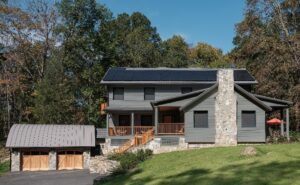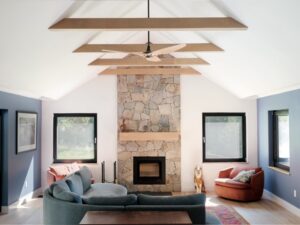 Daniel Colombini, an Ossining resident and a Principal at Goldman Copeland, the New York City-based consulting engineering firm, has won the US Department of Energy’s Blazing the Trail Grand Award for his LEED Platinum “Passive House” in Ossining. The national award recognizes “the builder with the most innovative use of technologies, materials, sensors, automation, and advanced controls to optimize the performance of the home.”
Daniel Colombini, an Ossining resident and a Principal at Goldman Copeland, the New York City-based consulting engineering firm, has won the US Department of Energy’s Blazing the Trail Grand Award for his LEED Platinum “Passive House” in Ossining. The national award recognizes “the builder with the most innovative use of technologies, materials, sensors, automation, and advanced controls to optimize the performance of the home.”
The award was presented to Colombini at the US DOE’s Housing Innovation Awards Ceremony in Salt Lake City on October 2. There Colombini also received a 2024 Housing Innovation Award, recognizing the most impressive and advanced homes among leading DOE Zero Energy Ready Home builders.
The award-winning single-family three-bedroom house with an attached garage has about 3,500 square feet of living space. It offers a new model for sustainable, energy-efficient, and cost-effective residences.
A “Passive House” is a high-performance building standard developed by the Passive House Institute and is the only internationally recognized, performance-based energy standard in construction. LEED is the world’s most widely used green building rating system, and LEED Platinum is its highest certification. The combination of LEED Platinum and “Passive House” certifications shows that the house meets the highest levels of energy-efficient and green design. The house is also “Zero Energy” – as certified by the US Department of Energy – and is both net zero and carbon neutral, including the home’s energy consumption and electric vehicle charging.
 Colombini, the engineer-homeowner, set out to create a new standard of suburban housing. The home is a partial tear-down and retrofit, meaning that the house that he originally purchased was torn down except for the foundation, which was retained, and 75% of the materials in the old house were reused and thereby diverted from landfill.
Colombini, the engineer-homeowner, set out to create a new standard of suburban housing. The home is a partial tear-down and retrofit, meaning that the house that he originally purchased was torn down except for the foundation, which was retained, and 75% of the materials in the old house were reused and thereby diverted from landfill.
The new house incorporates passive house principles including a high-performance thermal enclosure, airtightness and heat recovery, continuous balanced ventilation, high-performance glazing of windows and doors, shading and daylighting, and moisture control. The overall design provides an air quality that it is so high that Dan’s allergy-induced asthma disappeared.
The cost of construction was 8% higher than a traditional house. That additional cost will be paid off by energy savings within 10-15 years – with energy savings continuing to accrue thereafter.
The architect for the project is Christina Griffin of CGA Studio in Hastings-on-Hudson, NY. The contractor is Ed Nugent of Fort Montgomery, NY. The certification consultant is Integral Building + Design in New Paltz, NY. The landscape architect is Barbara Restaino of Restaino Design in Grahamsville, NY.
The house is located adjacent to the Teatown nature preserve, and all new planting and landscaping consists of native species, designed to improve storm water management and mitigate invasive species. The landscape designer was selected in part because she also works with Teatown, ensuring sensitivity in design to the landscape of the nature preserve.
“The Colombini house is a landmark project in Westchester,” said architect Christina Griffin. “Not only does it reach the highest standards of energy efficiency and sustainability, but it demonstrates that they can be attained at an additional cost that can be recouped through energy savings in about a decade – far less than the period of a typical home mortgage.”
“Energy-efficient and green design is vital, given the challenges of climate change,” said Colombini. “This house provides the home that my family wanted, while demonstrating that the highest standards can be attained cost-effectively. I hope that it provides an example that can benefit Westchester, New York, and the nation.”







